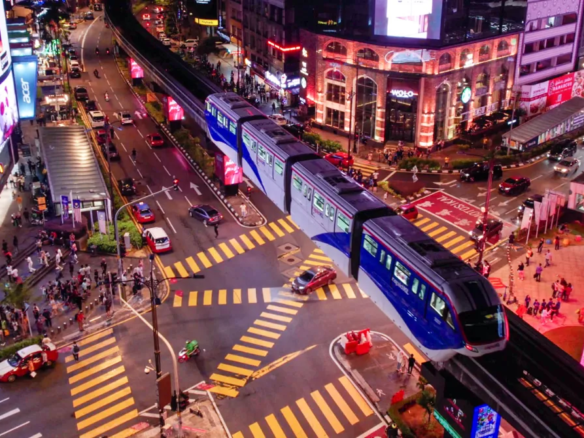In the heart of Kuala Lumpur, The Exchange 106 rises majestically as Malaysia’s second-tallest building, symbolizing the nation’s relentless pursuit of architectural excellence and innovation. Standing at a towering 454 meters, this skyscraper is not just a testament to modern design but also a marvel of engineering. Developed by Mulia Group Architects and led by Chief Development Officer Ali Moghaddasi, The Exchange 106 is the centerpiece of the sprawling 70-acre Tun Razak Exchange (TRX) development, poised to redefine the skyline of Malaysia’s capital city.
Pioneering Engineering: The Foundation of Success
The Exchange 106 is renowned not only for its height but also for the engineering mastery that underpins its construction. Central to this achievement was a groundbreaking collaboration among key players, including owner and project manager Mulia Property Development, EDP Consultants, China State Construction and Engineering, IM Technik, and YTL Cement. YTL Cement, in particular, played a crucial role in executing a record-breaking feat that set a new benchmark in Malaysia’s construction industry—the largest continuous concrete pour ever conducted in the country.
The Raft Pour: A Foundation Like No Other
A raft foundation is a critical component in the construction of skyscrapers, providing a thick concrete base reinforced with steel to evenly distribute the building’s weight. For a structure as massive as The Exchange 106, maintaining the integrity of the foundation was paramount. The construction of the foundation slab required an unprecedented continuous pour of concrete to ensure uniformity and strength. This complex process was spearheaded by YTL Cement, whose expertise and meticulous planning were pivotal in achieving this engineering milestone.
“A raft foundation is a thick concrete slab reinforced with steel, generally constructed as the foundation of a building. For a building of The Exchange 106’s calibre, we need to keep the integrity of the massive raft.”
— Lambert Liew, Buildcon (YTL Cement’s concrete arm) Senior General Manager
YTL Cement’s Role in the Record-Breaking Pour
YTL Cement’s involvement in the raft pour was a masterclass in coordination and execution. The project required pouring a staggering 19,438 cubic meters—or 45 million kilograms—of concrete, equivalent to eight Olympic-size swimming pools. This monumental task had to be completed within a tight two-day window, all while maintaining the concrete temperature below 28°C, a critical factor in ensuring the structural integrity of the foundation.
To accomplish this, YTL Cement meticulously planned every aspect of the operation, from sourcing raw materials to managing logistics. The preparation began seven months in advance, involving collaboration with experts from Indonesia, Australia, and China. The result was a seamless execution that set new standards in the construction industry.
Behind the Scenes: A Team Effort
The success of the raft pour was not just a result of advanced machinery and materials but also the culmination of a highly coordinated team effort. Over 150 technicians, drivers, and general workers were mobilized across multiple sites to ensure the continuous supply and delivery of concrete.
“Managing the raw materials was indeed a complex task. Nevertheless, as a vertically integrated entity, YTL Cement was able to have full control over the entire production process, from sourcing raw materials to delivering the finished products.”
— Lim Tze Liang, YTL Cement’s Construction Development Lab (CDL) General Manager
The materials used in the pour were sourced from various locations, including Janamanjung in Lumut, Batu Tiga quarries, and manufacturing plants in Padang Rengas and Kuala Kangsar. Special attention was given to maintaining the quality of the concrete, with each batch being rigorously tested to ensure it met the required standards. The logistical challenges were immense, particularly with the need to navigate the bustling traffic of Kuala Lumpur. To mitigate these challenges, the pour was strategically scheduled over a long weekend, minimizing the impact on the city’s traffic.
Overcoming Challenges: Innovation at Its Best
Executing a project of this scale was not without its challenges. The team had to contend with Malaysia’s unpredictable weather, potential delays in material delivery, and the need to maintain strict temperature controls. To keep the concrete cool during the pour, 2,000 tonnes of ice were sourced to replace part of the water content in the mix, preventing thermal stress and ensuring the integrity of the foundation.
The use of advanced insulation techniques and real-time monitoring systems further exemplified the innovative approaches adopted by YTL Cement. GPS and CCTV systems were employed to track the movement of mixer trucks, allowing the team to adjust delivery schedules dynamically based on real-time traffic conditions. This level of precision and adaptability was crucial in ensuring the project’s success.
Setting a New Benchmark in Construction Excellence
The completion of the raft pour at The Exchange 106 represents a significant milestone not only for YTL Cement but also for Malaysia’s construction industry. It showcases the nation’s ability to undertake and successfully execute large-scale, complex projects that require cutting-edge technology and exceptional project management skills.
“This world-class achievement by our team showcases a significant milestone in Malaysia’s engineering and construction history as well as adds another feather to our cap for delivering complex and technically sophisticated projects.”
— Lim Tze Liang
The Future of Construction in Malaysia
The Exchange 106 is more than just a skyscraper; it is a symbol of Malaysia’s engineering prowess and its potential to lead in the global construction arena. The lessons learned and the benchmarks set during this project will undoubtedly influence future developments in the country, paving the way for even more ambitious and innovative projects.
As Malaysia continues to grow and develop, the success of The Exchange 106 serves as a reminder of what can be achieved through collaboration, innovation, and a relentless pursuit of excellence. The towering structure now stands as a beacon of the nation’s aspirations, a testament to the skill and dedication of those who made it possible.



